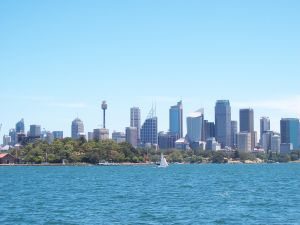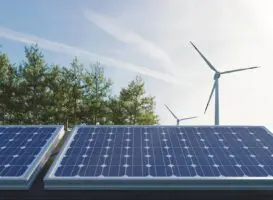This week the City of Sydney will release its final Trigeneration Master Plan which outlines the potential greenhouse gas reductions of Australia’s first citywide low-carbon energy network.
The City is in negotiation with Origin Energy’s Cogent Energy for a final contract to design, build, operate and jointly finance the trigeneration project. This follows the signing of an historic heads of agreement with Cogent in April after a two-year procurement process.
Trigeneration is a key part of the City’s ambitious plan to reduce carbon emissions from 2006 levels by 70 per cent by 2030 – one of the most ambitious targets of any Australian government.
The federal government recently announced two grants totalling $8.75 million to support the installation of trigeneration at the Green Square development, Prince Alfred Park Pool and Town Hall House.
The trigeneration network, running on natural or renewable gases, would be more than twice as energy efficient as a coal-fired power station and produce low-carbon electricity, heating and cooling for buildings while reducing greenhouse gas emissions by one third as well as reducing electricity consumption by 30 per cent and peak electricity demand by 60 per cent.
The City plans to replace centralised electricity generation, primarily from burning coal, which is responsible for 80 per cent of the greenhouse gas emissions from the City of Sydney Local Government Area (LGA). The City’s objective is to supply 70 per cent of electricity from trigeneration and 30 per cent from renewable energy sources such as solar and wind by 2030. A Renewable Energy Master Plan will be published later in 2012. It will quantify the different renewable resources available both inside and outside the LGA. This will include renewable gases from household waste, sewage and agricultural waste which will replace natural gas to fuel the trigeneration network.
The final trigeneration master plan identifies 477 MWe of capacity which would generate 70 per cent of the electricity for the Sydney Local Government Area and reduce greenhouse gas emissions by a third. This is an increase on the 360 MW capacity, detailed in the interim plan from December 2010 costed at $440 million (2010 dollars).
An additional 50 MWe capacity was identified at Green Square, University of Sydney, Australian Technology Park and Carriageworks, Entertainment Quarter (Moore Park) and the industrial precinct in the south of the Local Government Area.
For low density residential and small business areas of the LGA, such as Glebe, Newtown, Alexandria and Surry Hills, a further 67 MW of potential capacity in fuel cells was identified in the plan. Fuel cells are currently being trialled in NSW households by Ausgrid.
Inefficiencies and Grid Losses of Centralised Power Generation
More than two-thirds of primary energy is lost at remote power stations in the form of waste heat, a natural by-product of thermal electricity power generation, rejected into the atmosphere through power station cooling towers using significant quantities of water to reject the waste heat.
The efficiency of power stations in NSW range from 28 per cent efficiency for the coal-fired plant in the Hunter Valley to 42 per cent for the combined cycle gas-fired plant in Smithfield. nine out of the 11 primary power stations in NSW are coal-fired with an average efficiency of 34 per cent.
Grid transmission and distribution losses in NSW amount to 8.3 per cent reducing the efficiency of NSW grid electricity delivered to consumers to 31 per cent. The city’s grid efficiency is likely to be worse than this since its very large electrical load is at the end of the network and has very high peak loads due to the very large electric air conditioning load.
The poor efficiency of centralised energy has a cost that is being felt by NSW electricity consumers with rises in electricity bills, primarily driven by network charges transporting the electricity from remote centralised energy power stations to end consumers.
Grid Network Charges and Energy Growth
The UTS Institute of Sustainable Futures’ report ‘Close to Home: Potential benefits of Decentralised Energy for NSW Electricity Consumers’, established that over 2010-15, electricity network businesses in Australia will spend over $46 billion, more expenditure than the proposed $34 billion National Broadband Network.
In NSW, electricity networks are undertaking capital expenditure of $17.4 billion over the five years to 2013-14. This represents $2,400 per person and an 80 per cent increase on the previous five years. Average electricity prices in the Sydney electricity distribution network area are expected to increase by 83 per cent during this period with the proportion of electricity bills that goes towards network charges to rise from 40 per cent to 60 per cent.
The Institute of Sustainable Futures estimates the City’s plans to supply 70 per cent of the LGA’s electricity needs from a 360MWe trigeneration network by 2030 could achieve savings in deferred electricity network costs and avoided costs of new power station capacity to serve the city’s growing demand in the order of $1.5 billion by 2030.
Electric Air Conditioning and Peak Power
A key part of the reason for surging electricity prices is the need to build electricity assets for peak power demand, primarily due to electric air conditioning on hot days with the highest demand typically only occurring four days of the year. An estimated $11 billion of network assets is built to meet demand for just 100 hours a year and as much as 25 per cent of electricity costs result from peak demand, primarily electric air-conditioning, that occurs over a period of less than 40 hours a year.
A 2kW reverse-cycle air conditioner costs $1,500 a year to operate and yet imposes costs on the electricity network of $7,000 since it adds to peak demand. These network costs are not paid by the consumer operating the air conditioner, but by all NSW electricity consumers whether or not they own air-conditioners.
These network costs are significantly amplified by the city centre. The Trigeneration Master Plan will displace 542MW of electricity peak demand, primarily electric air-conditioning, which all NSW electricity consumers are currently paying for. This is equivalent to taking 271,000 – 2 kilowatt (kW) reverse-cycle air conditioners off peak electricity demand.
Coefficient of Performance
The coefficient of performance (COP) is a measure of the output to input energy of electric chillers. It is not a measure of efficiency since this ignores the primary energy supplying the input. A common mistake is made in the assumption that grid electricity is 100 per cent efficient. It is not. For example, the average COP of electric chillers in the city is 2.5. However, the electrical efficiency of the grid is only 31 per cent or less in the city so the overall COP or primary energy efficiency is 0.77 or less.
In order to avoid this misunderstanding and potential misuse of the term coefficient of performance (COP) the European Union determined that the energy efficiency of electric and gas chillers, heat pumps and similar equipment be calculated on the primary energy ratio (PER), which takes account of the efficiency of the electricity and grids, not just the COP. For electric chillers, PER = COP x 40 per cent (efficiency of the EU electric grid), for gas chillers, PER = COP x 91 per cent (efficiency of the EU gas grid) and for heat chillers, PER = COP x 100 per cent (as heat is taken directly from trigeneration).
When considering greenhouse gas emissions for chillers the refrigerant used by the chillers in addition to the energy consumption must also be taken into account. The Global Warming Potential (GWP) of the refrigerant most often used in electric chillers is HFC 134a which has a GWP of 1,430. In other words, 1 tonne of HFC 134a is equivalent to 1,430 tonnes of carbon dioxide. For heat-fired absorption chillers the refrigerant used (water/liquid salt) has a GWP of zero.
When designing a trigeneration network a holistic approach must be taken. For example, if absorption chillers with twice the COP were used this would have the effect of either reducing electricity generation by 50 per cent or rejecting 50per cent of the waste heat. Neither is desirable or efficient and would significantly reduce carbon abatement which is why the COP of absorption chillers have to be selected to fit the waste heat output to provide the most energy efficient engineering solution overall.
Air Quality Assessment
The trigeneration systems for the four low carbon zones will reduce absolute nitrogen oxide (NOx) emissions by over 5,000 tonnes a year. However, these NOx emissions will be reduced at the coal fired power stations, ie, in the Hunter Valley, and replaced by 220 tonnes of NOx emissions in the city. Across the Sydney metropolitan area, NOx emissions are approximately 91,000 tonnes a year so trigeneration would represent 0.2 per cent of Sydney’s NOx emissions compared to transport which represents 78 per cent of Sydney’s NOx emissions. Even the 0.2 per cent of NOx emissions will be more than offset by the implementation of other City of Sydney strategies, particularly the Connecting our City – Transport Strategies and Action Plans.
Following the procurement process the trigeneration systems will use Best Available Techniques in reducing NOx emissions by fitting selective catalytic reduction to the gas engines to reduce NOx emissions to 50 milligrams per cubic metre (mg/m3 )of air compared to the Interim DECC Nitrogen Oxide Policy for Cogeneration in Sydney and the Illawarra which specifies a maximum of 250mg/m3 of air. The 50mg/m3 of air is about half of the NOx emissions of a modern gas fired boiler which are used widely in central Sydney.
Efficiency of Trigeneration Engines
The procurement for the city wide trigeneration network required gas engines of the highest electrical efficiency available. The Master Plan was based on 4MWe gas engine modules as the optimal module size for the Low Carbon Zones. The gas engine module selected by the successful energy services company comprise, in the main, 4MWe modules with an electrical efficiency of 46 per cent and a thermal energy efficiency of 39 per cent.
Combined Cycle Gas Turbines
Combined cycle gas turbines (CCGT) outside the city were considered during the early stages of the Master Plan. Although manufacturers claim 55per cent electrical efficiency this is a peak efficiency rate and not an annual rate of efficiency on which trigeneration is based. Australia does not publish annual energy statistics but in the UK, which has a high level of CCGT penetration, does. This is known as the Digest of UK Energy Statistics, otherwise known as DUKES, and this shows that the gas power station fleet in the UK achieves 46-48 per cent electrical efficiency less grid losses over the year as a whole.
The only example of a CCGT power station in NSW is the CCGT plant at Smithfield which achieves an annual electrical efficiency of 42 per cent delivering less than 39 per cent efficiency to end consumers after grid losses. Due to the poor efficiency compared to trigeneration CCGT was not considered further.
City on track for major emissions reductions
The City has already reduced greenhouse gas emissions in its buildings by 18 per cent from 2009 to 2011 by building energy efficiency retrofits and has let a further building energy and water efficiency retrofit contract to reduce emissions by a further 24 per cent, increasing the total emission reductions to 42 per cent by the end of 2012-13.
The City has also let a contract to replace all City owned street lighting with LEDs over the next 3 years which will reduce emissions in its street lighting by 40 per cent.
Tenders have also been received for a large-scale program of solar photovoltaics on the City’s buildings which will be reported to Council later this year.
These initiatives, together with the trigeneration project, will set the City of Sydney on the path towards reducing emissions from its own buildings and operations by 70 per cent by 2030.
Allan Jones MBE is Chief Development Officer, Energy and Climate Change








